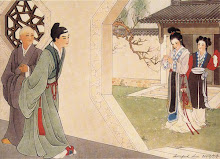Accompanying this sketch, Yu V Klitsenko writes:
The fund of the Krasnoyarsk Regional Museum of Local Lore preserved this sketch from pre-revolutionary Russia. The inscription reads: ‘Christian temple of the Tungus nomads on the river Iochimo’. The Tungus temple was sketched by an anonymous artist in forest lands belonging to the Evenkil, in the northern gold mining complex in the Yenisei Basin, north of the modern North Yenisei district of the Krasnoyarskii Krai.From the description of this The Evenki people had (and, God willing, will have again!) a unique approach to Christian worship that conformed to their nomadic-pastoralist lifestyle. The temple is on an elevated platform, of the sort that would be used by steppe peoples for shamanic ceremonies and ritual dances. The people would be gathered outside and underneath, in their yurts or their hide tents. They would offer prayers for successful hunts or for successful migrations. Because they lived in Siberia, success was not guaranteed for either, and failure often meant death.
MS Batashev, who first published this document, reports:
In the indigenous peoples’ ethnography fund of the KRMLL, a pen sketch is stored under manifest number 1610-3. The sketch shows a square building with a square building with a hipped roof, installed on an elevated platform. Behind the structure there is a log section with six ‘legs’, on which three eight-pointed Orthodox crosses are erected. In appearance, the log is close to some figures of the so-called ‘shamanic chum*’ – a ‘kalir’ (mythical giant wild deer) installed in the darpe gallery, or to the mythical shamanic elk, whose image was located in the onang gallery. The caption under the picture reads: ‘Christian temple [chram] of the Tungus nomads on the river Iochimo’. From the materials of the manifest, it is only known that the drawing was received by the fund in 1923 from a certain AS Gobov through museum employee AA Savel’eva. But, judging from the style of the signature, the sketch itself was made much earlier, even in pre-revolutionary times. This dating is supported also by the fact that the sketch is wrapped in a sheet torn from some printed bibliography, in which the latest date of the publications listed is 1893.Apart from this brief commentary, we have no further information about the origin of the portrayal, and the ‘Sitz in Leben’ of the building depicted on it.
Iochimo is a small river in the Velmo Basin, the region of the North Yenisei gold mines. Already by the middle of the 19th century there were 97 mines in this area, employing 22,000 people. Of course, the influence of Orthodox culture on the local Tungus population here was much stronger than in any other region of the North Yenisei, and the evident result of this was the appearance of such a structure, meeting both local conditions and the tastes of the local population.
The refusal to question the content of the inscription and the conviction that the Tungus structure in the drawing was indeed, at least from the perspective of the Evenkil of the Iochimo River, Christian, were accepted as an operating principle of the study. Indirect signs of the Christian nature of the building include the image of the three crosses, in the absence of ‘homokonov’ and other idols usual for shamanic prayer sites…
The poles upon which the temple stood, would be ornately adorned with icons of Christ, the Theotokos and various Russian saints, as well as prayer flags and tokens of offering. The Evenkil revered Christ as the ultimate Shaman--the Son of God who rescues the souls of all the dead at the cost of His own life. The worship of the Theotokos and the saints fit into the Evenki worldview as well, for of course the supreme God has helpers who can guide reindeer to good grazing areas, or keep hunters safe in the taiga forests.
Baptism also made a degree of intuitive sense to Evenki worshippers, as the cosmology of traditional Evenki religion involves a great river that stands between this world and the next, which all men must cross if they are to live on in the other world.
As well, the Evenki erected these large wooden crosses in front of such churches in memory of the dead.
Such temporary, small, portable places of worship would have been instantly recognisable to the (likewise nomadic-pastoralist) ancient Hebrews. God lived in a Tabernacle in the desert: that is to say, he lived in a tent, a ‘chum’. The love of the Evenkil for their marginal taiga lands, and for the reindeer with whom they lived in symbiosis, would have been understandable to, and approved by, the authors of the Hebrew Scriptures, who were of course biased toward the way of life of the shepherd.
It would seem, or rather it is to be hoped, that at least some of these churches survived, it seems, up until the Revolution... and not much further on than that. The aggressive atheism of the early Soviets did not permit the Evenki to worship Christ.
But, what a loss to the Christian world are such churches! That is not, of course, to say the building. The building was not, and never was, important. Indeed, it seems meant to be taken down and put up somewhere else. But rather, what a loss to the Christian world are the tent-gatherings of Indigenous peoples who could hear the words of Scripture, unfiltered by some self-serving colonialist missionary’s ‘interpretation’!
And thus, what a shame indeed, that Western Protestants (and Evangelicals in places like South Korea) are still trained think of the Evenki and other nomadic groups as ‘unreached people’, that they seek to turn into sedentary, suit-and-tie-wearing, joyless and self-righteous bourgeois children of hell like themselves. Give me the shamanism-inflected indigenous Evenki Christianity any day of the week, over the religion of such ‘missionaries’.
* ‘Chum’ is an ethnographical term for ‘a portable dwelling of nomadic reindeer herders in the form of a conical frame made of poles, covered with skins, birch or other bark’, similar to the tipi used by the people of the Seven Council Fires, or the wigwam used by the Anishinaabeg.




















